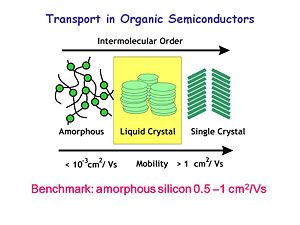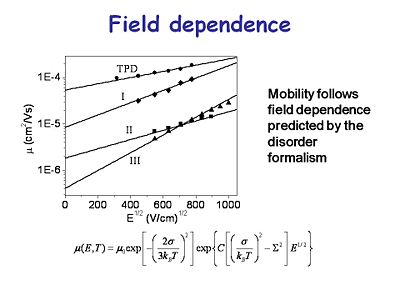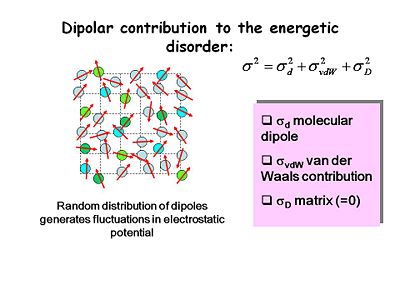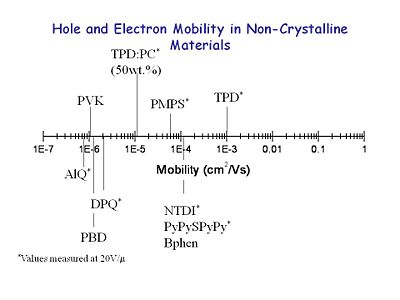OLED Charge Mobilities
Return to OLED Menu | Next Topic
Fundamentals of Charge Transport in Organic Solids
The concept of charge transport was developed first for crystal. Crystals have period structures, the band model applies and there is delocalization of electrons in the electron conduction band and holes in the valence band. This is the case with doped silicon. Amorphorous organic materials have charge localized in the form of an radical ion and it moves by interstitial hopping, that is hopping from molecular site to molecular site. This is intrinsically a less efficient process than in crystalline inorganic semiconductors. This is reflected in the mobility of charge carriers. Hole conduction and electron conduction occur in opposite directions as a result of an applied electric field. They do not occur at the same rate. In general electron conduction is a slower process than hole transport. In the early day there was an amorphous organic state, the liquid crystal state and the single crystal state. The benchmark mobility for amorphous silicon is 0.5 x 10 -1 cm2/Vs. Charge mobility is measured as a flux of charge over and area of one square centimeter per volt per second. If you get an organic materials to come anywhere close to that you have a real winner. Most organic materials have charge mobility of 10-3 cm2/Vs up to 1 cm2/Vs. This is important because it ultimately limits how thick you can make an organic device. OLEDs are made quite thin because of these low mobilities. Over the last two decades the mobility has risen, for example single crystal rubrene has been have shown to have mobilities around 10-15 cm2/Vs. There are liquid crystalline systems which good charge mobilities along the stacking axis. So the conventional wisdom that organic materials are low mobility does not have to be true.
Transfer Mobility Experiments
To measure mobility you create a thick film of the organic material, place it over the top of a transparent electrode and on the side place a collection electrode. Then fire a laser at a wavelength that will photogenerate charge carriers. There may be a sensitizer or the laser can be tuned to one of the absorption bands for the organic material. Suppose you use a nitrogen laser in the UV with a short pulse length which launches a sheet of charges into the organic layer. Then we measure the amount of time it takes for the charges to arrive at the collection electrode and then fall off. This is the time of flight or TOF. The vertical axis is the compensation current in the external circuit. We measure the transit time measured at the inflection point of the curve. Notice that as you increase the voltage of the system the transit time goes down. Electron mobilities are therefore field dependent. It is best to have non-dispersive transport in which charges start as sheet of charges and then move across the material as a sheet resulting in a very well defined transition. If the motion of the charges is more randomized, if there is lots of disorder in the solid and a lots of traps, then you get a less clear transition point. This is dispersive transport.
The second series of plots shows that the process is temperature dependent indicating that it is an activated process. This is activation of a charge from one molecular center, up and over a barrier and into another molecular center. This like the problem of electron transfer that Marcus first described and it is dependent on the internal and external reorganization energy that involves charge transfer from one species to another. It can be described in much the same manner that Marcus first described homogeneous electron transfer.
The disorder formalism (Bassler and Borsenberger)
There have been many efforts to describe this process formally. The disorder formalism of Bassler and Borsenberger has done the best job of describing what we see. Transport occurs by hopping through a manifold of localized states that are energetically and positionally disordered. This describes transport for most organic systems. Mobility can be expressed in terms of intrinsic mobility and a Boltzman-like expression that accounts for the energy barriers and the degree of disorder in the system. This accounts for the temperature dependence and the field dependence of transfer.
There are several contributions to energetic disorder including molecular dipole, Van der Waals or dispersive interactions and matrix interactions. Random distribution of dipoles generates fluctuations in electrostatic potential because local dipole fields could either help or hinder you from moving charge from one system to another. Most of the really good OLED materials are non-polar and have not intrinsic local dipoles.
Hole and Electron Mobility in Non-Crystalline Materials
Here are actual mobilities for non-crystaline materials. TPD is a bis aral amine which at the time was one of the better compounds with a mobility of 10-3. TPD when 50% diluted into polycarbonate (TPD:PC) results in mobility drop of two orders of magnitude. Poly vinyl carbazol (PVK) has been around for long while and it’s mobility is poor. Aluminu quinalate (AlQ), DPQ and PBD are electron transporter and emissive materials which also have low mobility. If you make an OLED with one of these hole transport materials and another electron transport material there will be an asymmetry in their rates.




